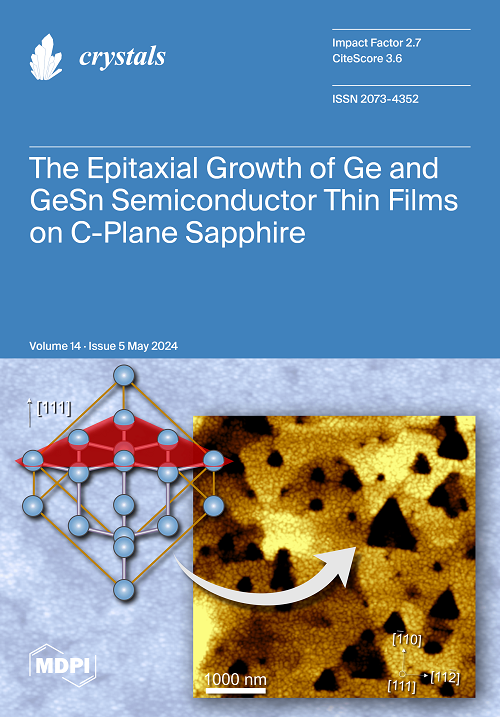Wafer-Scale ALD Synthesis of MoO3 Sulfurized to MoS2
IF 2.4
4区 材料科学
Q2 CRYSTALLOGRAPHY
引用次数: 0
Abstract
Silicon has dimensional limitations in following Moore’s law; thus, new 2D materials complementing Silicon are being researched. Molybdenum disulfide (MoS2) is a prospective material anticipated to bridge the gap to complement Silicon and enhance the performances of semiconductor devices and embedded systems in the package. For a synthesis process to be of any relevance to the industry. it needs to be at the wafer scale to match existing Silicon wafer-processing standards. Atomic Layer Deposition (ALD) is one of the most promising techniques for synthesizing wafer-scale monolayer MoS2 due to its self-limiting, conformal, and low-temperature characteristics. This paper discusses the wafer-scale ALD synthesis of Molybdenum trioxide (MoO3) using Mo (CO)6 as a precursor with Ozone as a reactant. An ALD-synthesized wafer-scale MoO3 thin film was later sulfurized through Chemical Vapor Deposition (CVD) to transform into stoichiometric MoS2, which was evaluated using X-ray photoelectron spectroscopy (XPS), Raman spectroscopy, Scanning Electron Microscopy (SEM), and Atomic Force Microscopy (AFM). The roles of activation energy and first-order reaction kinetics in determining the ALD recipe parameters of the pulse time, reactor temperature, and purge time are explicitly discussed in detail. Discretized pulsing for developing one-cycle ALD for monolayer growth is suggested. Remedial measures to overcome shortcomings observed during this research are suggested.晶圆级 ALD 合成硫化成 MoS2 的 MoO3
硅在遵循摩尔定律方面存在尺寸限制,因此,人们正在研究新的二维材料来补充硅。二硫化钼(MoS2)是一种前景广阔的材料,有望弥补硅的不足,提高封装中半导体器件和嵌入式系统的性能。要使合成工艺对行业有意义,就必须在晶圆规模上与现有的硅晶圆加工标准相匹配。原子层沉积(ALD)具有自限制、保形和低温特性,是合成晶圆级单层 MoS2 的最有前途的技术之一。本文讨论了以 Mo (CO)6 为前驱体、臭氧为反应物在晶圆级 ALD 合成三氧化钼(MoO3)的过程。随后,通过化学气相沉积(CVD)对 ALD 合成的晶圆级 MoO3 薄膜进行硫化处理,将其转化为化学计量的 MoS2,并使用 X 射线光电子能谱(XPS)、拉曼光谱、扫描电子显微镜(SEM)和原子力显微镜(AFM)对其进行了评估。详细讨论了活化能和一阶反应动力学在确定脉冲时间、反应器温度和吹扫时间等 ALD 配方参数中的作用。提出了用于单层生长的单循环 ALD 的离散化脉冲。还提出了克服本研究中发现的不足之处的补救措施。
本文章由计算机程序翻译,如有差异,请以英文原文为准。
求助全文
约1分钟内获得全文
求助全文
来源期刊

Crystals
CRYSTALLOGRAPHYMATERIALS SCIENCE, MULTIDIS-MATERIALS SCIENCE, MULTIDISCIPLINARY
CiteScore
4.20
自引率
11.10%
发文量
1527
审稿时长
16.12 days
期刊介绍:
Crystals (ISSN 2073-4352) is an open access journal that covers all aspects of crystalline material research. Crystals can act as a reference, and as a publication resource, to the community. It publishes reviews, regular research articles, and short communications. Our aim is to encourage scientists to publish their experimental and theoretical results in as much detail as possible. Therefore, there is no restriction on article length. Full experimental details must be provided to enable the results to be reproduced. Crystals provides a forum for the advancement of our understanding of the nucleation, growth, processing, and characterization of crystalline materials. Their mechanical, chemical, electronic, magnetic, and optical properties, and their diverse applications, are all considered to be of importance.
 求助内容:
求助内容: 应助结果提醒方式:
应助结果提醒方式:


